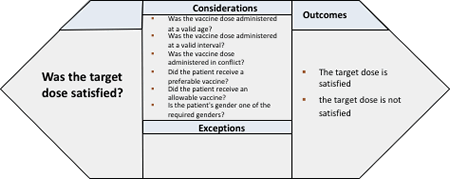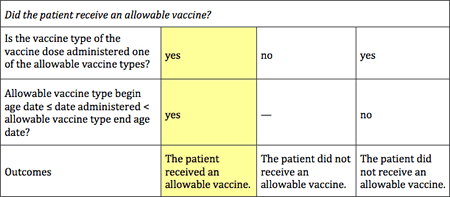Focus on What Makes Your Business Smart: From Interpretation to Implementation Step 2: Structure Business Logic
After working closely with business stakeholders in Step 1, business analysts need to apply methods and techniques to the information collected to produce structured deliverables. Compiling the results in business-friendly sets of structured deliverables enables analysts to
- ask the right questions at the right time.
- focus on the business need, not the system requirements.
- conduct effective impact analysis.
- provide knowledge transfer.

Step 2 — Structure Business Logic
|
The goals of this step |
|
|
Responsible parties |
|
|
Techniques and methodology |
|
The key components that drive the smarts of your business are business concepts, business rules, and decisions. The deliverables associated with each of these are
Business concepts
- Concept model
- Glossary of terms
Operation business decisions
- Decisions
- Decision structures
- Decision tables
Business rules
- Business rule statements
- Business rule groups
Concept Model
A concept model consists of
- a graphical representation of how your business concepts or vocabulary relate to each other, and
- a glossary of these terms and their definitions.

Figure 1. Example of structured business vocabulary (concept model) and glossary of terms.

A concept model addresses questions that a process model would not address. For example, the concept model will provide information on 'how a patient is related to an antigen series', 'how an order is related to a subscription', or 'what is the difference between platinum, gold, or silver customers'.
Operational Business Decisions
Operational business decisions can be complex. Diving right into details will not be effective and will cause confusion and frustration. The following is a set of deliverables that allows you to look at decisions from a top-down approach. Each artifact has a distinct objective to enable understanding and communication before going to the next level of detail.

Figure 2. Example of a decision structure (Q-Chart).[1]

A Q-Chart (Question Chart) is a visualization of how one or more operational business decisions are formally organized. The Q-Chart answers the questions of how decisions are dependent on each other.

Figure 3. Example of a decision (QCOE — question, consideration, outcome and exception).[1]

A QCOE is a graphic representation of an operational business decision indicating what question ("Q") is being asked, and possibly one or more of the following:
- Consideration ('C')
- Outcomes ('O')
- Exceptions ('E')
This artifact guides you to think through carefully the question you want to answer, how the outcome matches the question, the considerations required to determine the outcome, and any exceptions.

Figure 4. Example of a decision table in a rule-by-column format.
A decision table is a structured means of visualizing decision rules in rows and columns. A decision table identifies the appropriate outcome for each case it covers. A decision table is a great way of communicating the specific considerations for each outcome. This artifact provides the answer to 'why did I get this outcome?'
Decision tables come in many different shapes and sizes. Figure 5 provides a legend of different styles.

Figure 5. Legend of different styles of decision tables.[2]
Business Rules
A business rule is a criterion used in business operations to guide behavior, shape judgements, or make decisions.
| A vaccine dose administered must be considered an allowable vaccine if all the following are true:
|
Figure 6. Example of a business rule.
Business rules provide the answer to 'why '. A business rule or a set of business rules enables you to understand why things are done or decided in a certain way.

Figure 7. Example of a business rule group.

Business rules are organized and managed in groups. Due to the sheer volume of business rules in your domain, you will not be able to manage one business rule at a time. This artifact answers the question of how the business rules relate to or impact each other.
Just Remember…
Plainly speaking, here are some of the main things you need to remember:
- Business rules are what you need to answer the question 'why' things are done or decided in a certain way.
- Producing the artifacts in this step enables you to ask the right questions at the right time to guide knowledge workers through the thinking process in specifying their requirements.
- Some business rules are better expressed in statement format, while other business rules are best expressed in table format.
For further information, please visit BRSolutions.com
References[1] Decision Analysis: A Primer… How to Use Decision Speak™ and Question Charts (Q-Charts™) by Ronald G. Ross. www.BRSolutions.com ![]()
[2] Decision Tables: A Primer… How to Use TableSpeak™ by Ronald G. Ross. www.BRSolutions.com ![]()
# # #
About our Contributor:
Online Interactive Training Series
In response to a great many requests, Business Rule Solutions now offers at-a-distance learning options. No travel, no backlogs, no hassles. Same great instructors, but with schedules, content and pricing designed to meet the special needs of busy professionals.










How to Define Business Terms in Plain English: A Primer
How to Use DecisionSpeak™ and Question Charts (Q-Charts™)
Decision Tables - A Primer: How to Use TableSpeak™
Tabulation of Lists in RuleSpeak®: A Primer - Using "The Following" Clause
Business Agility Manifesto
Business Rules Manifesto
Business Motivation Model
Decision Vocabulary
[Download]
[Download]
Semantics of Business Vocabulary and Business Rules